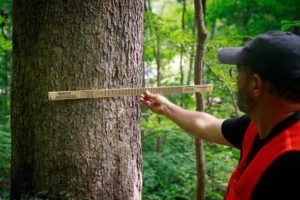White Oak Initiative: The TREEmendous importance of White Oak
Oak trees are keystone species, meaning that entire ecosystems depend on them. From providing food through their acorns or acting as habitat for wildlife like birds and small mammals, oaks are an important part of Michigan’s habitat. One species in the oak family is the white oak, these trees are prized for their strength and durability in the timber industry, generating billions of dollars annually. White oak forests occupy more than 104 million acres of public and private forestland across the eastern and central United States but there’s been a developing issue with white oaks . Foresters have found that older trees are not being replaced by younger saplings at a sustainable rate due to a change in ecological factors. These factors include changes in land management practices, competition, environmental change and now a new invasive disease: oak wilt.

Oak Wilt is a fungal disease that moves through the vascular system of the tree. The fungus spores are carried to the tree by sap-feeding beetles that feed on sap from fresh wounds caused naturally or man-made (such as pruning). The disease can also spread from already infected oaks by moving through root grafts between trees of the same species. If you notice leaf discoloration, wilted/curled leaves complete leaf drop that occurs by mid-summer, dead crowns (upper portions of the trees) or suckering (miniature tree-looking shoots) at the base of the tree please contact Michigan DNR Forest Health Division.
The White Oak Initiative (WOI) is comprised of a group of conservation organizations that are committed to the long-term sustainability of white oak. A recent report released by WOI shows that in the next 10 to 15 years, white oak forests will decline significantly due to ecological and anthropogenic factors. The goal of the WOI is to educate the public and landowners in order to spread information about how best to preserve and restore white oaks. Acting now offers the best chance to preserve white oaks for the future. MUCC is a proud partner of the White Oak Initiative and will be happy to provide outreach materials about white oak at our outreach events.
To learn more about WOI, please visit: https://www.whiteoakinitiative.org/
The post White Oak Initiative: The TREEmendous importance of White Oak appeared first on Michigan United Conservation Clubs.



